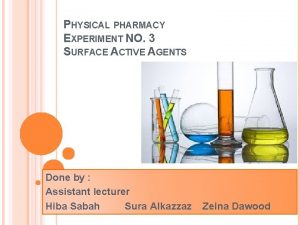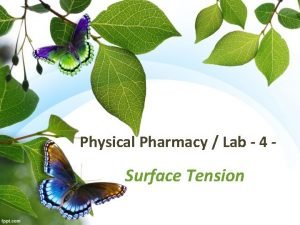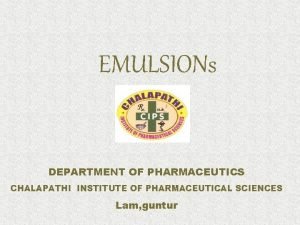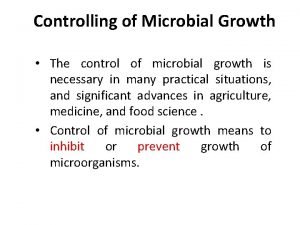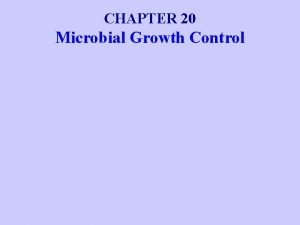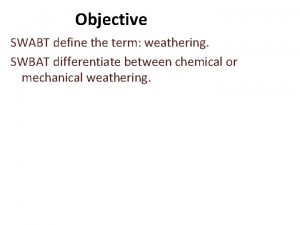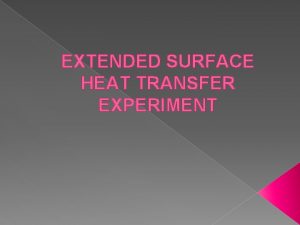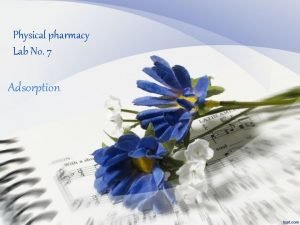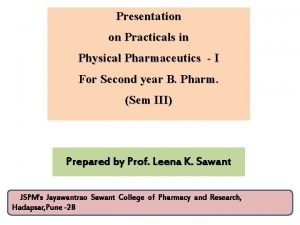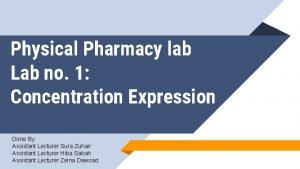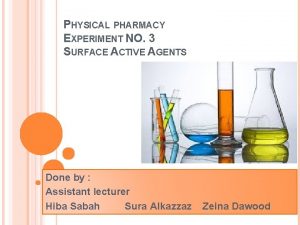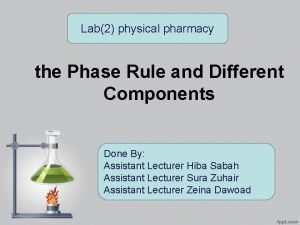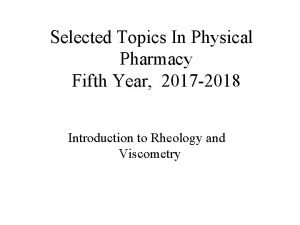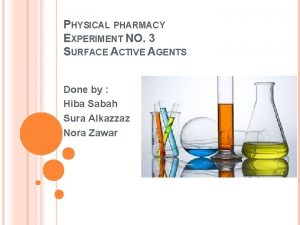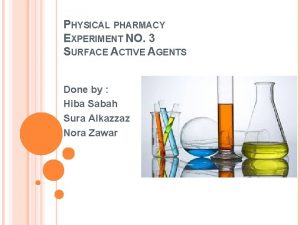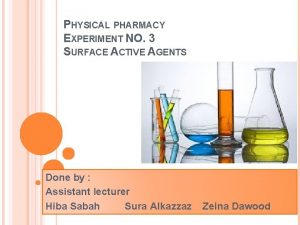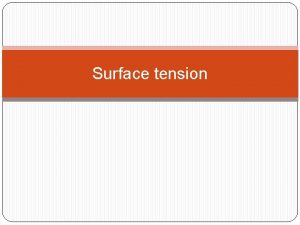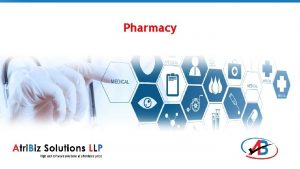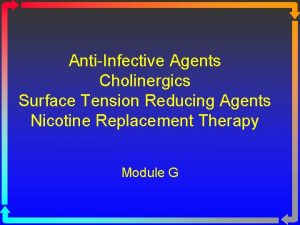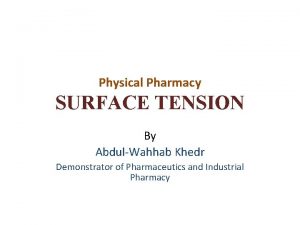PHYSICAL PHARMACY EXPERIMENT NO 3 SURFACE ACTIVE AGENTS
















- Slides: 16

PHYSICAL PHARMACY EXPERIMENT NO. 3 SURFACE ACTIVE AGENTS Done by : Assistant lecturer Hiba Sabah Sura Alkazzaz Zeina Dawood

introduction Surface-active agent or surfactant are molecules and ions that are adsorbed at interfaces. Surfactants are materials that lower the surface tension (or interfacial tension) between two liquids or between a liquid and a solid. An alternative term is amphiphile, which suggests that the molecule or ion has a certain affinity for both polar and non-polar solvents. They are used in many pharmaceutical preparations as wetting agents, emulsifiers, solubilizing and antifoaming agents.

When such molecule is placed in an air-water or oilwater system, the polar groups are attached or oriented toward the water, and the non-polar groups are oriented toward the air At the air-water interface, or oriented toward the oil at the oil-water interface (Figure 1).

Surfactants are classified According to their chemical structure and, more specifically, their polar group: Anionic surfactant such as sodium dodecyl sulfate (SDS®) Cationic surfactant such as cetyl trimethyl ammonium bromide (CTAB®) Ampholytic (Zwitterionic®) surfactant such as phospholipids Non-ionic surfactant such as poly oxy ethylene (Tween®)


Micelles and the critical micelle Amphiphiles are characterised by having two regions of opposing concentration solution affinities within the same molecule or ion. When Surface active agents present in a liquid medium at low concentration, the amphiphiles exist separately (a size as a sub-colloidal). As the concentration is increased, aggregation occurs over a narrow range of concentration. These aggregates which may contain 50 or more monomers, are called micelles. Because the diameter of each micelle is of the order of 50 Å micelle lies within the size range designed as colloidal.

In general, Micelles are lipid molecules that arrange themselves in a spherical form in aqueous solutions. The formation of a micelle is a response to the amphipathic nature of fatty acids, meaning that they contain both hydrophilic regions (polar head groups) as well as hydrophobic regions (the long hydrophobic chain). The location of the molecule undergoing solubilisation in a micelle is related to the balance between the polar and non-polar properties of the molecule. The increase in solubility is due to adsorption or incorporation of the solute molecules into or in the colloidal particle (micelle).

pes of micelles: Spherical micelle. Cylindrical micelle. Bilayer micelle.

Critical Micelle Concentration (C. M. C): The concentration of monomers at which micelles form. An important property of amphiphilic colloid in solution is the ability of the micelle to increase the solubility of materials that are normally insoluble or only slightly soluble in the dispersion medium used this phenomenon is known as solubilisation. Experimental work Part l: bring Salicylic acid powder, Tween 60, distilled water, phenol red indicator, volumetric flask (50 ml), conical flask (50 ml), graduated pipettes, burette, filter paper, funnel, and a balance. Prepare Na. OH Solution (0. 05 N). Part ll: The aim of the experiment is to show the effect of

Procedure: 1. Prepare different concentration of tween 60 (0%, 0. 05%, 0. 5%, 1%, 2%, 3%), prepare 50 m. L of each solution (use volumetric flask and pipette) from stock solution 5% (C 1 V 1=C 2 V 2). 2. Place 25 ml of each concentration in a conical flask of (50 m. L) then add 0. 25 g salicylic acid to each flask. 3. Shake the flasks for 10 minutes. 4. Set to settle for another 10 minutes to permit the undissolved salicylic acid to settle down (filter if necessary). 5. Withdraw 10 m. L of filtrate solution and titrate with standardized Na. OH solution (0. 05 N) using phenol red as indicator. The end point is a point when the colour changes from yellow to pink. Measure the end points.

Step no(1) of procedure To prepare 50 ml of 0% tween 60 that mean we will not use tween 60 , just add 50 ml D. W in the volumetric flask To prepare 50 ml of 0. 05% tween 60 from 5%stock solution by using dilution C 1 V 1 = C 2 V 2 5 %*V 1 =0. 05%* 50 V 1= 0. 5 ml take from stock solution 5%tween 60 (using pipette ) put it in the volumetric flask then complete the volume to 50 ml by adding D. W *The same procedure and calculation for preparation of the other concentration

prepare 50 m. L of different concentration of tween 60 from stock solution 5%tween 60 (C 1 V 1=C 2 V 2). Steps of experiment Shake the flasks for 10 minutes Set to settle for another 10 minutes (filter if necessary). Place 25 ml of each concentration in a conical flask add 0. 25 g salicylic acid to each flask. Withdraw 10 m. L of filtrate solution and titrate with standardized (0. 05 N) Na. OH solution using phenol red as indicator. Measure the end points.

1 M. wt of salicylic acid= 1 M. wt Na. OH 1 eq. wt of salicylic acid= 1 eq. wt Na. OH 138. 1 g = 1 L of 1 N Na. OH 138. 1 g =1000 ml of 1 N Na. OH (138. 1/1000) g =1 ml of 1 N Na. OH 138. 1/1000*0. 05 =1 ml of 0. 05 N Na. OH Therefore, 0. 0069 g of salicylic acid is the chemical factor. Chemical factor* end point= g salicylic acid/10 ml.

If the end point for 0%tween 60 was 2. 6 ml The calculation will be End point *chemical factor = g of salicylic acid in 10 ml (filtrate) 2. 6 ml * 0. 0069 =0. 0179 g of salicylic acid in 10 ml The solubility of salicylic acid in (g100 ml) 0. 0179 g 10 ml X 100 ml X= 0. 179 g100 ml of salicylic acid *The same calculation for other end points

Conc. of tween 60 E. P (m. Ls of Na. OH) Grams of S. A in 10 m. L Grams of S. A in 100 m. L 0% 0. 05% 0. 5% 1% 2% 3% Solubility of S. A g/100 ml 0, 6 0, 5 0, 4 0, 3 0, 2 0, 1 0 0 0, 5 1 1, 5 2 2, 5 Concentration of tween 60 3 3, 5

 Surface active agents
Surface active agents What is surface tension
What is surface tension Ultrasonifier
Ultrasonifier Raising agents in food
Raising agents in food Physical agents for controlling microbial growth
Physical agents for controlling microbial growth Physical antimicrobial agents
Physical antimicrobial agents Mechanical and chemical weathering venn diagram
Mechanical and chemical weathering venn diagram Extended surface heat transfer experiment
Extended surface heat transfer experiment Active high and active low
Active high and active low Primary active transport and secondary active transport
Primary active transport and secondary active transport Primary active transport vs secondary active transport
Primary active transport vs secondary active transport Adsorption in physical pharmacy
Adsorption in physical pharmacy What is cst method in physical pharmaceutics
What is cst method in physical pharmaceutics Physical pharmacy lab
Physical pharmacy lab Cmc in physical pharmacy
Cmc in physical pharmacy Phase rule in physical pharmaceutics
Phase rule in physical pharmaceutics Physical pharmacy topics
Physical pharmacy topics
